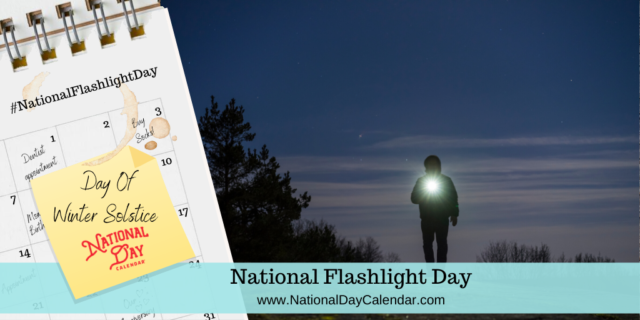
National Flashlight Day, on the same day as Winter Solstice, reminds us to turn on some lights during the shortest day of the year.
- The flashlight was invented in 1898 and patented in 1899. The biblical quote “let there be light” was on the cover of the 1899 Eveready catalog advertising the new flashlight.
- In 1887, the very first dry cell battery was invented. Unlike previous batteries, it used an electrolyte paste instead of a liquid electrolyte.
- In 1888, a Russian immigrant and inventor named Conrad Hubert founded the American Electrical Novelty and Manufacturing Company (later renamed Eveready). Hubert’s company manufactured and marketed battery-powered novelties. For example, neckties and flower pots that lit up. Batteries were still a novelty at that time, then only recently introduced to the consumer market.
- Around 1899 the invention of the dry cell and miniature incandescent electric light bulbs made the first battery-powered flashlights possible.
- January 10, 1899 – British Inventor David Misell obtained U.S. Patent No. 617,592, assigned to American Electrical Novelty and Manufacturing Company. This electric device designed by Misell was powered by “D” batteries laid front to back in a paper tube with the light bulb and a rough brass reflector at the end. The company donated some of these devices to the New York City police, who responded well to them.
- ‘Flashlights’ are also known as ‘torches’, which is a reference to original flamed torches.
- The term ‘flashlight’ comes from the early style torches, that did not project light consistently but rather were required to be flashed on and off due to the lack of power available from the battery, and the type of switch used.
- The very first flashlights included a light, battery and reflector in a paper cylinder and after significant improvements in a twenty year period, the electric torch had become quite popular, due to their safety factor (compared to candles and kerosene lamps) and ease of use.
- Starting from the late 1990’s camping flashlights no longer needed solely batteries or bulbs to function. With the introduction of LED (Light Emitting Diode) technology, the first LED flashlights were born as well and they were way more efficient and durable than the conventional ones. With LED camping flashlights, you no longer have to worry about changing batteries and running out of power. This kind of light source uses semiconductor technology.
- LEDs can last anywhere between 12 to 22 years.
- These bulbs produce light but not in the same efficiency as a common light bulb. A common light bulb will eat electricity but only converts 10% of that electricity into light. The other 90% is wasted energy. An LED, however, converts 100% of the energy into light.
Sources:












